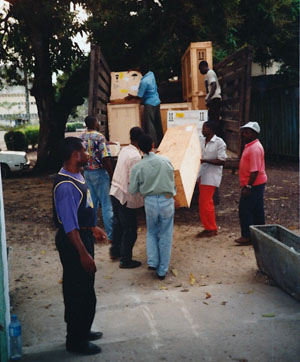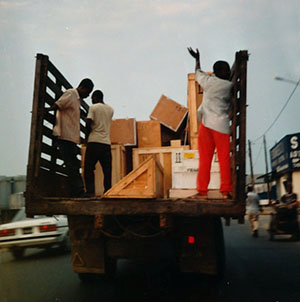| Texts | Peter Herrmann. Stuttgart, 1994 |
| A&A |
| Exhibition Concept: AROUND AND AROUND |
1994, 1995, 1999, 2000. |
After an initial experimental exhibition on the aesthetic confrontation between contemporary western art and traditional African art - displayed in the rooms of the Achim Kubinski Gallery in 1994 – we, gallerists Achim Kubinski and Peter Herrmann, decided to further break away from conventional presentation formulas. Encouraged by the very positive response to our collaborative show and the inquiries that soon followed regarding the conditions of adopting such a project, we decided to accept an invitation to Cameroon, where Pan-African organisation UNAFAS was holding its first meeting. On the occasion of this inaugural gathering and in light of a newly developing global awareness, the participating African politicians committed themselves to greater involvement in the arts; it was in this spirit that the Cameroon Ministry of Culture extended us an official invitation to exhibit Around & Around. In Germany, the Foreign Office also expressed a great deal of interest in the show, providing us with funding that was incorporated into the project in cooperation with the German Institute for Foreign Cultural Relations. For us organisers of the project, it was important that the first expanded exhibition take place beyond the usual centres of cultural and proceed in a wholly decentralised manner. This idea was warmly welcomed in Cameroon, where we developed a very fruitful cooperation with then-nascent Doual’Art, the country’s only art association, which graciously made its spaces available to us for the exhibition. The old palace of King Douala Manga-Bell is one of the most beautiful examples of German colonial architecture in Cameroon; pregnant with history, it is perfectly suited to evoke both the highs and lows of bilateral relations between the two countries. Not least for that reason did we receive enthusiastic support from the local German consulate and secure yet additional corporate sponsors like, for example, African Security and Omega Transport. In this constellation, Around & Around became a huge success for everyone involved. The exhibition concept was developed in a two-year planning phase. After 25 years working in the international art industry, Achim Kubinski was attracted by the notion of expanding his professional horizons Kahnweiler-style with traditional African art. The collaboration with Peter Herrmann, who works with both traditional and contemporary African art, allowed him to do just that. What at first seemed like a conservative approach of hearkening back to ancient African traditions was accorded a distinctly forward-looking aspect by the inclusion of contemporary African artists establishing themselves on the global art scene. Western artists, whose interest has until recently just grazed Africa, became curious; the quality of the artists that Kubinski was able to secure for the project speaks volumes to the extent of that curiosity. Given the respective backgrounds of the two gallerists, it was natural that the thematic foundation of the project be, at least initially, the connection between sub-Saharan Africa, North America, and western Europe. But as the planning stage moved forward, an additional foundation was laid – namely, an inner dynamic by which participating artists would be alternated from exhibition site to exhibition site. Around & Around would travel the world in a state of permanent self-evolution, thereby incorporating as many facets of the intercontinental art scene as possible. In selecting the artists, we first decided on equal representation of African and western artists and then chose, in each category, both artists with existing international reputations and those still in the process of making a name for themselves. Our selection of contemporary western artists was restricted to those whose works have no connection to classic Modern figurative art, some of whom work directly with contemporary African artists. Individual works of traditional African art were then incorporated into the exhibition according to aesthetic considerations, each contemporary piece complemented by a corresponding traditional one. The artists responded enthusiastically to this concept; without exception, they saw it as an enrichment of their own work to be shown with traditional objects by unknown masters. The interconnections thereby established rendered the discrepancies in notoriety of the individual artists unproblematic. To a certain extent, the Around & Around concept mirrors our own theoretical reflections on the artistic relations between these continents and cultures – more precisely, our belief that the art world is entering the Fourth Phase of a process of cross-continental fertilisation. The First Phase, of which Paul Gauguin can be seen as representative, was the western discovery of the exotic, the heroised wild. The Second Phase was the embracing of the form of African and Oceanic art, its inherent principle of abstraction; the best-known representative of this phase is Pablo Picasso. Josef Beuys is the best example of an artist from the Third Phase, which centred on African art’s underlying spiritual principle of shamanism. No single artist can yet be seen as representative of the Fourth Phase because it is only just beginning; here, Around & Around seeks to work interpretatively. We see African cultural historical development as exemplary of this phase. For many years, contemporary African art attracted virtually no international interest, with the exception of a few essentially reproductive pieces produced in the traditional African style. The prevalent impression was that art production in Africa was at a disadvantage compared to its western counterpart. Today, however, much has changed. More and more Africans are asserting themselves on the international art scene with creative output that is entirely unique; these artists have developed their very own artistic language largely independent of western currents. For the most part, this language has its philosophical roots in Africa, but the artists’ choice of technique, form, and material no longer bear the typical stamp of the continent. While the African artists who were welcomed in Europe during the first three phases remained anonymous – their work the expression of their respective self-contained and isolated tribal cultures – those of the Fourth Phase are emerging as independent, recognisable figures in the global art world and have been strongly influenced by a hybrid and cosmopolitan urban culture that continues to spread across their continent. These new artists actively call for a revised understanding of the world and art’s place in it; they challenge the purely euro-centric conception of art that has dominated for so long and seek thereby to integrate themselves in the contemporary international art scene. The persistent demands of this wide array of artists for the art world to finally abandon its centralistic paradigms of thought in favour of more global philosophies have had an effect that has been increasingly recognised in the political and economic sectors. In the fields of music and literature, this development has already progressed in a definite, recognisable way, which is now carrying over to the visual arts as well. It is precisely this development that we as curators want to encourage with the Around & Around concept. Until now, the reception of African art (primarily from the 19th century) has boiled down to a paternalistic romanticisation born during the classic Modern period; contemporary African art, for its part, has been evaluated ethnologically rather than aesthetically. Around & Around seeks to undermine this cliché image through an experimental juxtaposition of works from different backgrounds. Our postmodern, non-ideological, illustrative method is meant to shed new light on the coexistence of different cultures and epochs. The inner dynamic of the exhibition concept acts as a signifier of an ongoing process of change. The concept itself consciously encompasses and exploits socially conservative views of the past in order to fully do justice to the individual messages of international artists in a forward-looking manner. In contrast to more traditional approaches, we dispense with the usually superficial search for immediately recognisable art historical connections and circumstantial affinities between works and artists. We believe, instead, that it is precisely the dichotomies between pieces that reveal new, aesthetically interesting connections. Consider, for example, the relationship between Volume by Joseph Kosuth, Nigerian Woman Shopping by Sokari Douglas-Camp, and the pottery of Lawson Oyekan, seemingly disparate works that nonetheless share a common intention. Another high point of the exhibition was the pairing of a four-coloured, architecturally austere space designed by Günter Förg with a divination figure looking skyward in four directions by an unknown Ekoi artist from Cameroon. The stele character of this piece contrasted well, in turn, with a column by Heimo Zobernig, in whose diminution this connective circle closes itself in a rare completion. When Pietro Sanguineti, whose video installation was featured in the exhibition, arrived at the Doual’Art spaces with 14 picture clippings from a comic book that he wanted copied and enlarged by sign painters in acrylic on plywood, a similarly symbolic process was set in motion as when Michel Würthle captured Martin Kippenberger on canvas in Greece while Zairian artist Cheri Samba painted his accompanying commentary, which was then subsequently shown at Around & Around in Cameroon. The renown of the participating artists and objects made the exhibition in Douala one of the most important exhibitions on intercultural aesthetics to ever take place in sub-Saharan Africa. The presentation in Africa of traditional African objects long held in western museums and collections is a novelty. In the past, individual attempts have been made to exhibit these pieces in their places of origin, but Around & Around consciously brought objects from other African countries to the exhibition spaces in Cameroon. As far as we know, traditional African objects have never been presented in this way. Anyone familiar with the difficulties of organising an exhibition can readily imagine the enormous amount of work and energy that went into presenting in Douala. Just a decade ago, Cameroon was one of the most stable countries in Africa; today, it is in the throes of a profound, virtually unstoppable economic recession. One of the first sectors affected by such a crisis is always the cultural one. As in other African countries, cultural work in Cameroon is almost exclusively limited to the activities of the cultural establishments of a handful of industrial nations – first and foremost amongst them, the Goethe Institut and the Centre Culturel Français. Because these institutions have a national-representative character, their work must be contained within a proscribed set of thematic parameters. The representatives of these establishments were hugely excited to welcome Around & Around to Cameroon; all parties viewed the exhibition as an important and necessary supplement to their own work. This enthusiastic response should encourage the creation of additional stops on the Around & Around tour and arouse the interest of our potential sponsors. A wider breadth of the public visited our exhibition in Douala than ever visited those shows purely organised by on-site cultural institutions. More visitors means more media and publicity, and we’re confident that interest in Around & Around will only grow from exhibition to exhibition and once a catalogue has been published. Peter Herrmann. Stuttgart, 1994 |
||
We predict that in the coming years, a closer collaboration between art and business will become increasingly necessary. In that spirit, we are constantly working to increase the attractiveness of the project for potential and existing sponsors. We hope that additional sponsors feel moved to support the continuance of Around & Around. The Foreign Office has set an early example, and we hope that other institutions, companies, and bearers of culture follow suit and deem this exhibition worthy of their support. |
|
Involved Organisations Ministry of Foreign Affairs, Bonn |
 |
![]()

